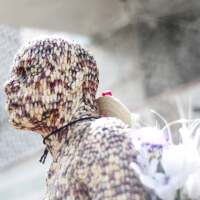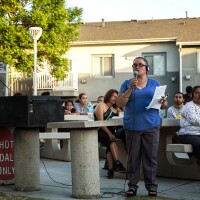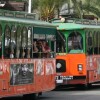Latinx Community Activism and Social Art Practices Get A Rare Spotlight in New Exhibit

This is produced in partnership with Pacific Standard Time: LA/LA, a far-reaching and ambitious exploration of Latin American and Latino art in dialogue with Los Angeles.

It’s not often that artworks that emerge out of community activism and social practices get center stage in art galleries, which makes the latest exhibit at Otis College of Art and Design a particularly unique and poignant one.
“Talking to Action: Art, Pedagogy, and Activism in the Americas,” which runs now through Dec. 10 at the college’s Ben Maltz Gallery, is a multimedia exhibit that offers a rare glimpse into several ongoing social art practices that amalgamate activism, community organizing, education and art in the Americas. This installation is one of the many exhibits currently taking place across Southern California that fall under the umbrella of The Getty’s "Pacific Standard Time: LA/LA" initiative that explores Latino and Latin American art in connection to Los Angeles; and “Talking to Action” illustrates these efforts through videos, sculptures, maps, drawings, audio recordings and archival materials.
Bill Kelley, Jr., who spent four years curating and organizing “Talking to Action,” believes this art show gives a voice to the underrepresented. “These are all artists working with communities that are not generally represented in the mainstream art context,” he says. “That’s the beauty of what community practices are about.”
In describing the themes behind “Talking to Action,” Kelley, Jr. does reference terms more commonly used in the United States like “social practice,” which is art that involves social interaction or creates social dialogue, but he says this “all-encompassing term does not exist in Latin America.”
“In many ways, many of the practices [in Latin America] that we may call ‘social practice’ have very little relationship to the art world. [Art is] also a part of it, but these things don’t necessarily get displayed [in galleries],” Kelley, Jr. says, adding that the people behind these practices normally get their feedback from academia or social movements, rather than the art world.
When Kelley, Jr. was choosing artists and art collectives to present in his show, he made sure to pick ones who had previously exhibited their artwork in galleries before. “These are artists who have committed to visualizing their work in a way that’s part of a continuum of a social dialogue and towards a larger socio-political and pedagogical goal,” he says. “This is all something they’re doing because it’s part of their impulse to communicate.”


The projects on display at “Talking to Action” represent just a fraction of the artists’ ongoing, years-long social practices. “We’re talking about an artist working ten years on a single project, for example, and these types of iterations that you find in a gallery aren’t the culmination of the project,” Kelley, Jr. says. “They’re usually just one moment in time, [and the artist] will continue on with the same project, and [then] go do some other iteration of it.”
These are long-term projects that will continue to have roots in teaching, learning, documenting and collaborating, and expand upon that. An example of one such project at “Talking to Action” is Ultra-red and School of Echoes’ traveling “Los Angeles Library for Anti-Gentrification.” The art collective has focused on the debate surrounding gentrification and displacement in Boyle Heights. They gathered the pamphlets, photos and videos that they made with the community as part of a resistance movement, and used these materials to create their first anti-gentrification library. The idea of the show is that it travels, everywhere from San Francisco to Chicago, and as it journeys through these cities, the library grows to include materials that illustrate the unique gentrification issues affecting these specific places.

Kelley, Jr., who is also an assistant professor of Latin American and Latino Art History at California State University Bakersfield, has been following these artists and their social practices for well over a decade. The artwork from these exhibits cover the countries of Argentina, Brazil, Chile, Colombia, Ecuador, Mexico, Peru and the United States. He was careful in how he approached curating this exhibit, with the understanding that it’s “absolutely unethical” to just send curators to these countries and bring their work back to the United States. “You’re finding art history in a context that’s not yours,” Kelley, Jr. says.
Instead, Kelley, Jr. worked with a team of researchers from six different cities in the Western Hemisphere to get their input on how to prioritize themes and projects from their home countries. “You start saying, ‘Well, this is one way to collectively have a conversation about what is shared across the Americas, [and find out] what connects São Paolo to Quito to Los Angeles to Tijuana,’” Kelley, Jr. says. “And that way, L.A. is not a dichotomy or a contrast to Latin America. It’s [part of] a dialogue, which is one point along many various points on the map.”
An example of this shared connection in “Talking to Action” is the work of Liliana Angulo Cortés, an artist, scholar and researcher whose three-channel video installation, “Pacific Time,” focuses on the history of black and Afro-Colombian social movements in Colombia and the United States. Angulo Cortés' work documents the black nationalist movement in the port city of Buenaventura in Colombia, and exhibits how stowaways traveling on boats from Buenaventura ended up in another port city of Oakland, California, and had contact with the Black Power Movement and the Black Panthers in the United States. Kelley, Jr. says Angulo Cortés was one of the few persons to research that connection, which makes this piece a special contribution to academia.

Other artwork on display in “Talking to Action” include the empowering fabric murals from BijaRi. The art collective that’s based in São Paolo painted on fabric words that described the history and current conditions of the people living in the Santo Domingo Savio (SDS) community in Medellín, Colombia, and laid them over rooftops. Community members, many of whom had fled from violence in their hometowns to the SDS community, could see these murals while riding Metrocable aerial cable cars.



In experiencing “Talking to Action,” visitors will find that there is no linear flow to the exhibit, which Kelley, Jr. says he did on purpose. Instead, the connecting thread is that there are similar patterns of pedagogy, dialoguing, map-making, and interest in social justice issues among all these projects.
Kelley, Jr. feels that “Talking to Action” is different than the other exhibits in "Pacific Standard Time: LA/LA." He says it’s the only one that is about social and community-based practices and features indigenous art. There’s also a special element of enacting social practice. “We really involved students and other communities,” Kelley, Jr. says. “It’s not just about social practice — we try to enact social practice. Students will hold seminars and devote projects to several artists in communities we supported, [and in] different cultures within those cities, here locally as well as in Tijuana and across the Americas.”
He hopes visitors who experience “Talking to Action” will learn that there are other kinds of art practices and world views that exist in Latin America. “My hope is that they find that they’ll look at something and begin to tease out that the world is very vast place — a massively, universally large place — and that perhaps in the shadows of the art world’s attention to economy, that there are these things happening on the edges that are really quite beautiful and interesting and that they should be looked at.”



